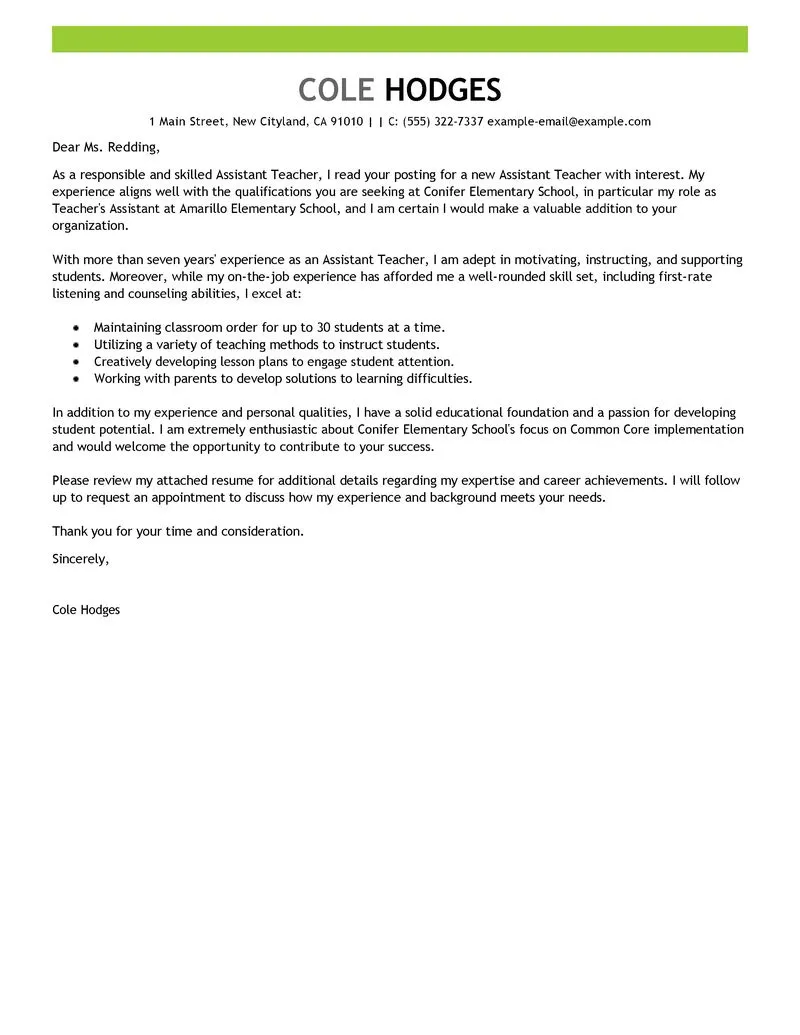Understanding the Teacher Assistant Role
A Teacher Assistant (TA) plays a vital role in supporting the educational environment and the effective functioning of a classroom. They work collaboratively with the lead teacher to create a conducive learning atmosphere for students. This involves a variety of tasks, from assisting with lesson preparation and classroom management to providing direct support to students, especially those who need additional help or have special needs. The responsibilities of a TA can vary depending on the school, the grade level, and the specific needs of the students. Understanding these diverse responsibilities is the first step to crafting a compelling cover letter that highlights your suitability for the position.
Key Responsibilities of a Teacher Assistant
The duties of a teacher assistant are multifaceted, encompassing both instructional and administrative support. A well-crafted cover letter should showcase your ability to effectively handle these diverse responsibilities. This could include the ability to support teachers, assist students, and manage activities. The key to writing a successful cover letter lies in your ability to align your skills and experiences with the specific requirements of the role, demonstrating a proactive approach to student learning and classroom management.
Supporting Teachers
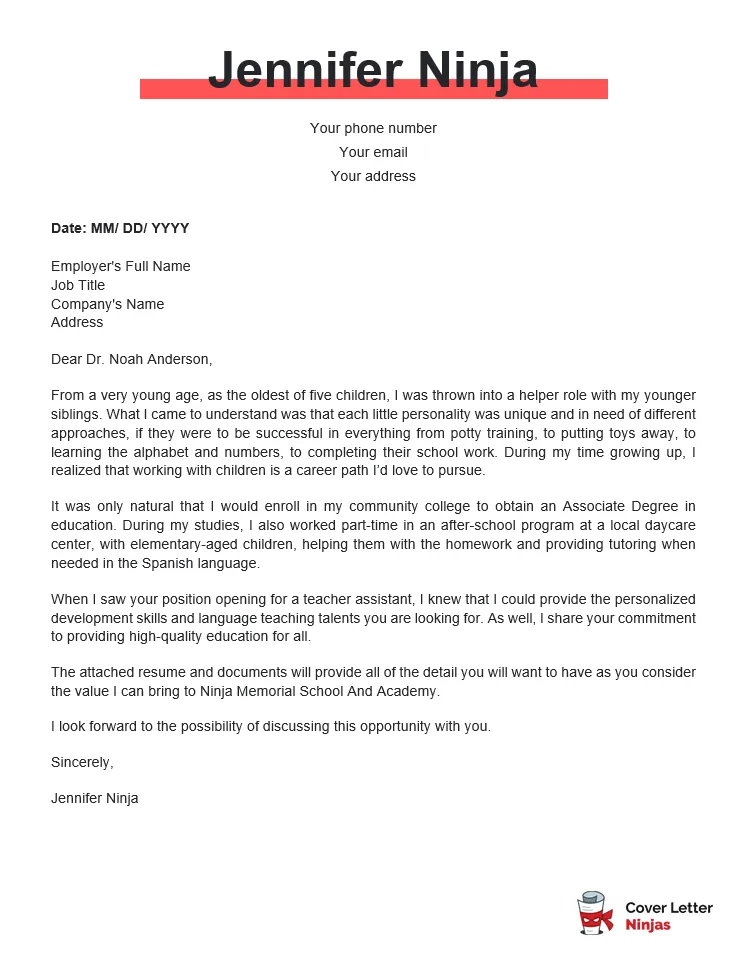
Teacher assistants are essential partners to educators, and supporting the lead teacher is a critical part of the job. This involves helping with lesson preparation, gathering materials, and setting up activities. The support can also include preparing learning resources, grading papers, and maintaining the classroom environment. Emphasize your ability to be organized, efficient, and proactive in anticipating the teacher’s needs. For example, you might mention your experience creating bulletin boards, preparing learning materials, or assisting with administrative tasks that allow the teacher to focus on instruction. A cover letter should show that you are a supportive team player.
Assisting Students
Another core responsibility of a teacher assistant is providing direct support to students. This can range from helping students with their assignments to offering individualized attention to those who need extra help. This might include working with small groups, tutoring individual students, or assisting students with special needs. In your cover letter, highlight your experience working with children, your patience, and your ability to adapt your teaching style to meet the diverse needs of students. Showcase your ability to encourage students, provide positive reinforcement, and foster a positive learning environment.
Managing Classroom Activities
Teacher assistants often play a crucial role in managing classroom activities and ensuring a smooth learning environment. This can include supervising students during activities, monitoring classroom behavior, and assisting with transitions between lessons. Highlight your organizational skills, your ability to manage groups of children, and your capacity to maintain a structured and positive learning environment. Include examples of your experience in managing classroom behavior, organizing activities, and assisting with transitions, emphasizing your ability to create a productive and positive atmosphere for learning. Your cover letter should make it clear that you can effectively manage the classroom.
Essential Components of a Teacher Assistant Cover Letter
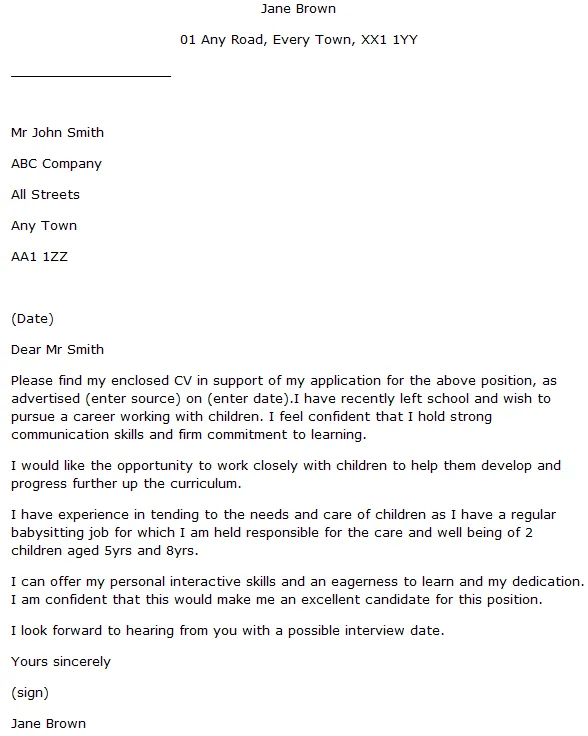
A well-written cover letter is essential to landing a job as a teacher assistant. It’s your first opportunity to make a positive impression and demonstrate your suitability for the role. A strong cover letter should have several key components, including your contact information, a professional greeting, a compelling opening paragraph, and sections that highlight your relevant skills and experience. You should also showcase your passion for education, provide specific examples, and quantify your achievements. Pay close attention to the formatting and proofreading your letter to ensure a professional presentation. It’s about making a good impression and creating a compelling message that showcases your skills.
Contact Information and Date
Start your cover letter with your contact information, including your full name, address, phone number, and email address. This information should be clearly displayed at the top of the letter. Directly below your contact information, include the date. This allows the hiring manager to know when the letter was written. It is a simple yet essential part of a cover letter that allows the reader to immediately see how to contact you and the date of your application. Ensure the information is accurate and up-to-date.
Professional Greeting
Address the hiring manager by name whenever possible. If you can find the name of the hiring manager, it demonstrates that you have taken the time to research the position and the school. If you’re unsure of the hiring manager’s name, use a professional greeting such as “Dear Hiring Committee” or “Dear [School Name] Hiring Team.” Avoid generic greetings such as “To Whom It May Concern.” It shows a proactive and personalized approach that will make you stand out from other applicants.
Opening Paragraph
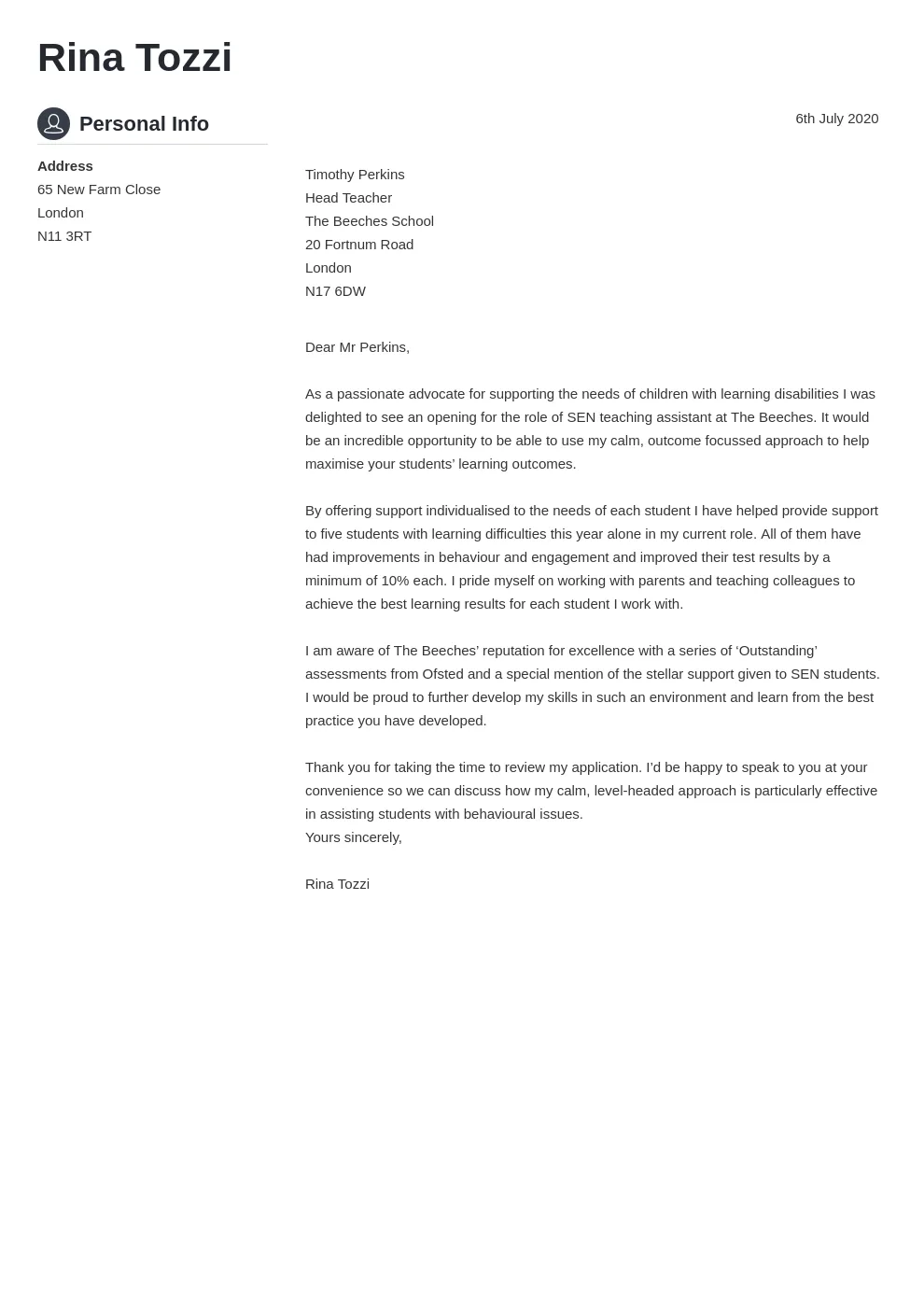
Your opening paragraph should immediately capture the reader’s attention. State the position you are applying for and how you learned about the opportunity. Briefly summarize your key qualifications and your enthusiasm for the role. Briefly explain why you are interested in the position and what you bring to the table. This section is your chance to make a strong first impression, so make it count. Create a clear and concise statement that captures the hiring manager’s attention and provides a quick overview of your relevant skills.
Highlighting Relevant Skills and Experience
This is the core of your cover letter. Provide specific examples from your experience that demonstrate your skills and qualifications for the teacher assistant position. Focus on the skills and experiences mentioned in the job description. This section needs to convince the hiring manager you are the right person for the job. Be specific and provide details about your roles and responsibilities, as well as any notable achievements. Show how you’ve used your skills and experiences to benefit students and teachers.
Classroom Management Skills
Highlight your classroom management skills, such as your ability to maintain order, manage student behavior, and create a positive learning environment. It could include your experience using different behavior management techniques, creating classroom routines, and addressing student conflicts. Provide concrete examples of how you’ve successfully managed a classroom or helped teachers manage their classrooms. Showcase your skills to create an orderly learning environment, as well as your ability to address student conflict.
Communication and Interpersonal Skills
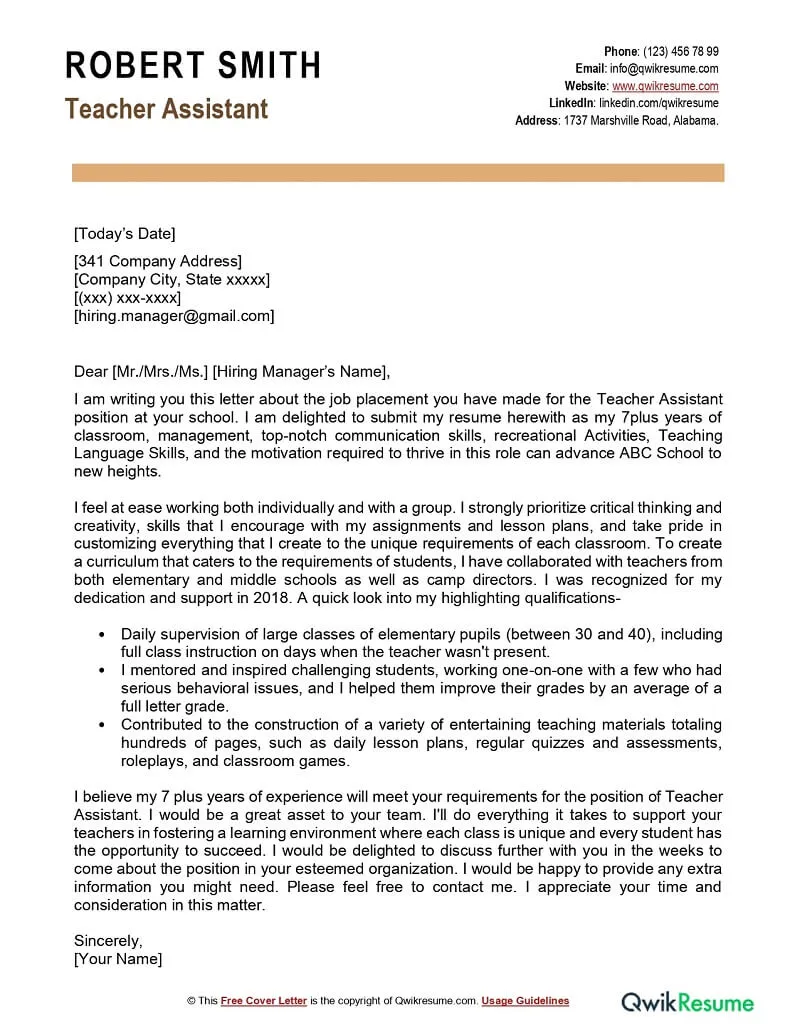
Teacher assistants need strong communication and interpersonal skills. Highlight your ability to communicate effectively with students, teachers, and parents. Give examples of times you’ve successfully collaborated with teachers, communicated with parents about student progress, or resolved conflicts. Emphasize your ability to build positive relationships with students and colleagues. Your cover letter should highlight communication as a key strength.
Experience with Student Support
If you have experience providing student support, be sure to highlight it. This can include working with students with special needs, providing tutoring, or assisting students with their assignments. Describe your experience working with students who need extra help, adapting teaching methods, and providing individualized attention. Provide examples of how you’ve helped students succeed. If you have worked with children with special needs, emphasize your understanding of their requirements and your patience.
Emphasizing Your Passion for Education
Showcase your genuine passion for education and your commitment to helping students succeed. Explain why you enjoy working with children and what motivates you to pursue a career as a teacher assistant. Share your interest in the school’s mission and values. This is the perfect place to convey enthusiasm for the role. Explain why you want to be a teacher assistant and what inspires you. Highlighting your passion will leave a memorable impact.
Showcasing Your Understanding of Child Development
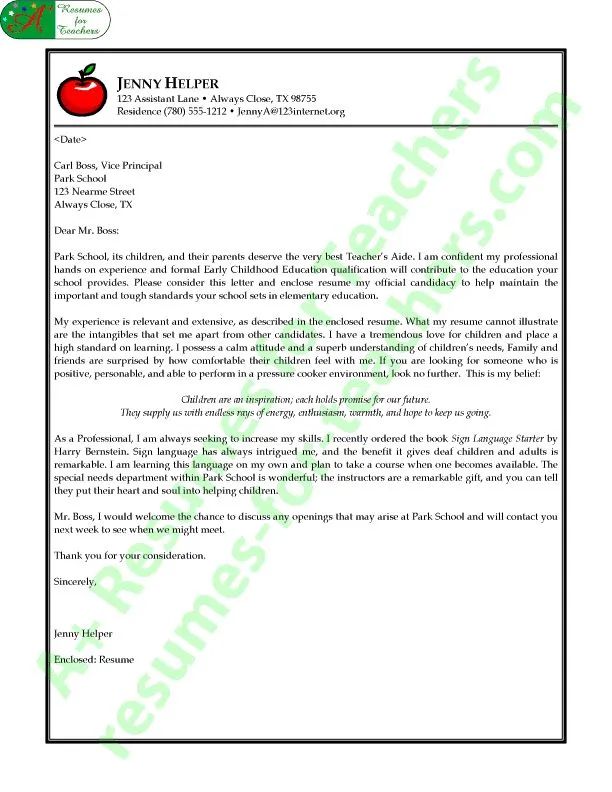
Demonstrate your understanding of child development and how it influences learning. Briefly discuss your knowledge of child development stages and how you can adapt your teaching approach. Mention any relevant coursework, workshops, or training that has prepared you for this role. If you have a good grasp of how children learn and develop, include that in your letter.
Providing Specific Examples
Instead of simply listing skills, provide concrete examples that showcase your abilities. Use the STAR method (Situation, Task, Action, Result) to describe your experiences and achievements. Explain the situation you were in, the task you were assigned, the actions you took, and the positive results you achieved. Provide specific examples of your experience. By providing specific examples, you will give your words credibility and make your application stand out.
Quantifying Achievements
Whenever possible, quantify your achievements. Use numbers, percentages, or data to demonstrate the impact you’ve made in previous roles. For example, you might mention that you improved student test scores by a certain percentage or successfully managed a classroom of a certain number of students. Using quantifiable data demonstrates that you are results-oriented and effective.
Tailoring Your Cover Letter
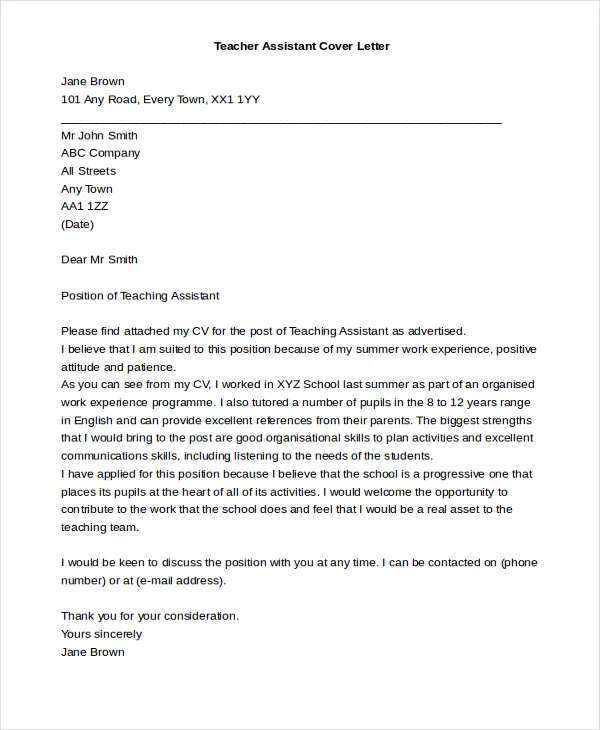
It’s crucial to tailor your cover letter to each specific job application. This ensures that you highlight the most relevant skills and experiences for the position and demonstrate your genuine interest in the specific school or district. Research the school or district to learn about their mission, values, and specific needs. This will enable you to write a more compelling cover letter that demonstrates your understanding of their needs and your commitment to their goals.
Researching the School or District
Before writing your cover letter, take the time to research the school or district. Visit their website, review their mission statement, and learn about their values and initiatives. Pay attention to the specific needs and priorities mentioned in the job description. This research will help you tailor your cover letter to address the specific requirements of the position and demonstrate your interest in the school.
Addressing the Specific Job Requirements
Carefully review the job description and identify the key skills, experience, and qualifications the employer is seeking. Use the language from the job description in your cover letter and provide specific examples that demonstrate how you meet those requirements. Make sure your cover letter highlights the qualities that the employer is specifically looking for. Doing this significantly increases your chances of getting the job.
Proofreading and Editing
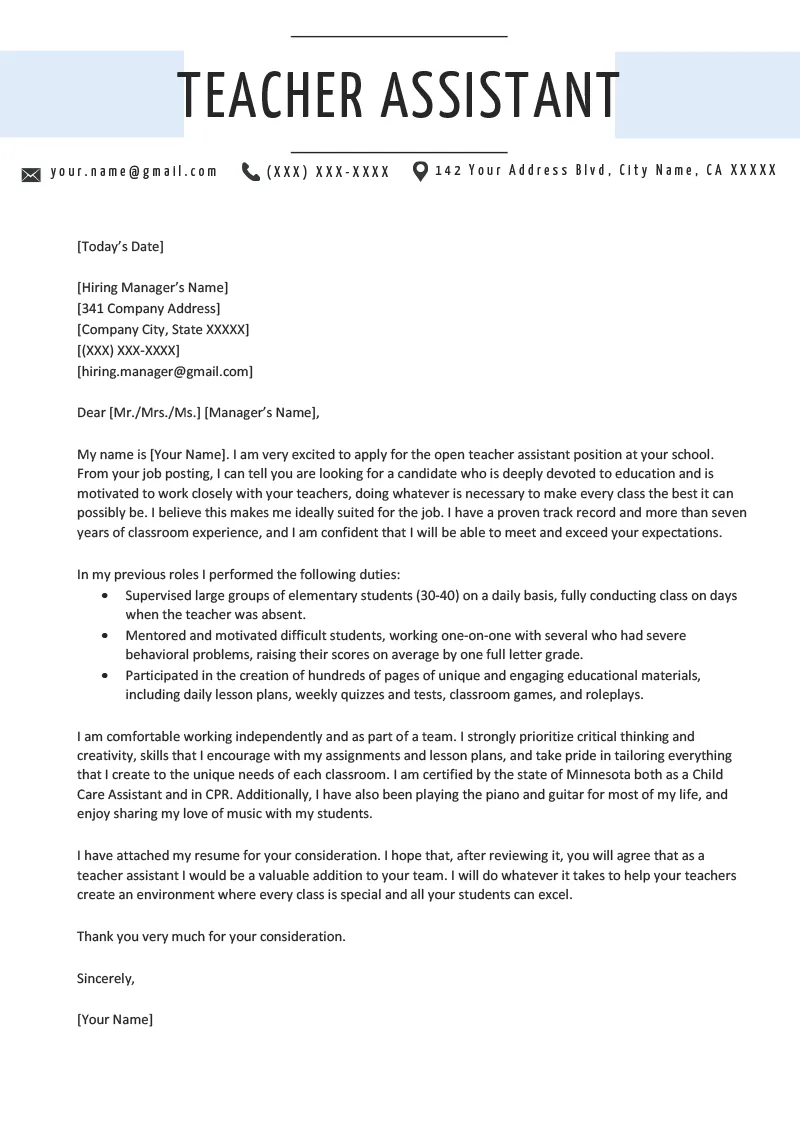
Proofreading and editing your cover letter is essential. Typos, grammatical errors, and formatting mistakes can create a negative impression. Always proofread your letter carefully, and consider having someone else review it as well. Mistakes will hurt your chances of getting the job. Ensure your cover letter is polished and professional. Pay attention to both grammar and spelling and the overall presentation.
Formatting Your Cover Letter
Proper formatting is essential for a professional-looking cover letter. Use a clear and easy-to-read font, and maintain consistent margins and spacing throughout the document. Aim for a clean and professional look. Formatting can make a big difference in how your letter is viewed.
Font and Size
Choose a professional and easy-to-read font, such as Times New Roman, Arial, or Calibri. Use a font size between 10 and 12 points. Avoid using overly decorative or difficult-to-read fonts. This ensures that your cover letter is easily readable.
Margins and Spacing
Use standard 1-inch margins on all sides of your cover letter. Double-space between paragraphs and use single-spacing within paragraphs. Ensure the spacing is consistent throughout the document to enhance readability and create a clean, professional appearance. The proper spacing improves the readability of your letter.
Examples of Effective Cover Letter Sections
To help you get started, here are some examples of effective cover letter sections. Use these examples as a guide to write your own compelling cover letter that highlights your skills, experiences, and passion for the role. These examples illustrate how to showcase skills and show you know how to make a good cover letter.
Opening Paragraph Examples
Here are examples of effective opening paragraphs to spark your creativity.
Example 1: “I am writing to express my enthusiastic interest in the Teacher Assistant position at [School Name], as advertised on [Platform]. With my [Number] years of experience working with children in educational settings and my passion for fostering a positive learning environment, I am confident I possess the skills and dedication to make a valuable contribution to your team.”
Example 2: “As a highly motivated and compassionate individual with a strong background in child development, I am eager to apply for the Teacher Assistant position at [School Name]. My experience in [Specific Experience] has equipped me with the skills necessary to support students and contribute to a nurturing classroom atmosphere.”
Highlighting Skills and Experience Examples
Here are a few examples of how you might highlight your skills and experience in the body of your cover letter.
Example 1: “In my previous role as a classroom assistant at [School Name], I was responsible for supporting the lead teacher with lesson preparation, classroom management, and student support. I regularly assisted in creating engaging learning materials and activities, which led to a [Percentage]% improvement in student participation.”
Example 2: “During my volunteer work at [Organization], I worked directly with students with special needs, providing individualized tutoring and assistance. I developed and implemented strategies to help students improve their reading comprehension and math skills. For example, the use of tailored materials improved student grades by an average of 10%.”
Closing Paragraph Examples
Here are a few example closing paragraphs that summarize and end on a strong note.
Example 1: “Thank you for considering my application. I am excited about the opportunity to contribute to [School Name]’s mission and believe my skills and experience align perfectly with the requirements of this role. I have attached my resume for your review and welcome the opportunity to discuss my qualifications further in an interview. I look forward to the possibility of joining your team.”
Example 2: “I am confident that my experience and passion for education make me a strong candidate for this position. I am eager to learn more about this opportunity and how I can contribute to the success of your students and school. Thank you for your time and consideration. I look forward to hearing from you soon.”
Common Mistakes to Avoid
Several common mistakes can undermine your cover letter and reduce your chances of getting hired. Avoiding these pitfalls can significantly improve your application. Be aware of the common mistakes to ensure you do not make them.
Generic Cover Letters
Avoid sending generic cover letters that are not tailored to the specific job or school. Generic letters show a lack of interest and effort. Tailor each cover letter to the specific job to increase your chances of getting hired.
Typos and Grammatical Errors
Typos and grammatical errors can damage your credibility. Always proofread your cover letter carefully to ensure it is free of mistakes. This shows that you take the application process seriously.
Lack of Personalization
Do not use generic greetings like “To Whom It May Concern.” Always address the hiring manager by name, if possible. This shows that you have taken the time to research the position and the school and that you are genuinely interested. Personalize your cover letter to show you have done your homework.
Submitting Your Cover Letter
Follow the instructions provided in the job posting regarding the submission process. Ensure that your cover letter and resume are correctly formatted and submitted in the required file type. Following submission instructions increases your chance of getting the job.
Formatting and File Type
Submit your cover letter as a PDF file unless otherwise specified. PDF files preserve the formatting and ensure that the document appears as intended. If the job posting specifies a particular file type, make sure to follow those instructions. Ensure the file name is professional and includes your name and the position.
Follow-up Strategies
After submitting your cover letter and resume, it’s a good idea to follow up with the hiring manager. Following up demonstrates your interest in the position and keeps you top of mind. Be polite and professional in your follow-up. Remember to be polite and professional when communicating with the hiring manager.
